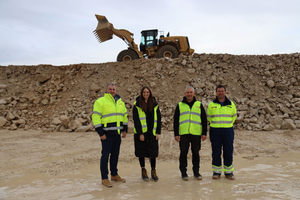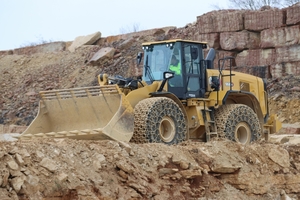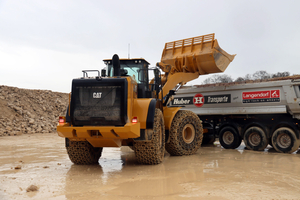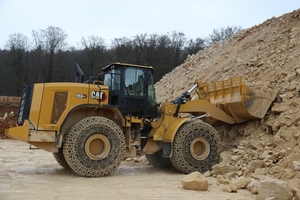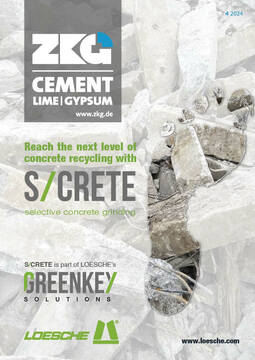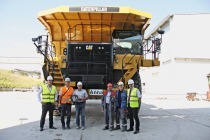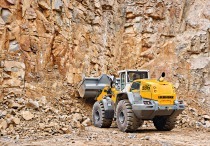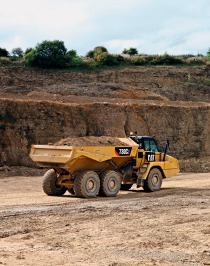Simple and functional: Cat 966 GC wheel loader proves
its worth in raw material loading
Ever heard of the “KISS principle”? The idea is to make products as simple as possible. As is the case with the Cat 966 GC wheel loader. Thanks to these characteristics, the family-run company Walter Huber GmbH in the central Franconian district of Weißenburg-Gunzenhausen uses one of these to supply the Solnhofer Portland cement works with raw materials for cement production. This means loading material loosened by large borehole blasting and building up stockpiles - after all, the rotary kiln in the cement works requires a constant supply.
The family business Huber Transporte has always worked with Cat construction machinery. Initially it was a wheel loader such as a 980, but a 966 eventually prevailed. From the C to the K series to the current GC series, the company has accompanied the development of wheel loaders in the 22 t class.
Once the construction machines in the transport company have reached the threshold of 10000 operating hours, they usually need to be replaced. “Then the resale price is still okay before the major repairs start,” is the argument put forward by company owner and partner Dieter Huber. This led to an equipment exchange, which was initiated by Wolfgang Wagner, senior sales representative at the Zeppelin branch in Erlangen. He offered the company a 966 GC. “For us, the wheel loader is a good solution that is interesting in terms of price. Even if there are a few downgrades compared to the high-tech version, we need a functional and simple loader with hydraulic pilot control for our loading application,” says the entrepreneur.
The wheel loader is designed for light to medium-duty loading tasks. However, the operating conditions on site are quite challenging when the wheel loader fills its Logmatic bucket, which is over four cubic meters in size, with limestone. That’s why the wheel loader was fitted with L5 tires from Bridgestone. “We‘ve been using them for years - our 966K was on the road for 11000 hours with one set of tires. The Bridgestone tires don‘t bounce as much because the rubber compound is harder, but it suits our application better. The tire doesn’t wallow, we have better traction and you can apply more force when you penetrate into the pile,” says Dieter Huber.
Self-locking differentials on the construction machine increase traction in the ground conditions in the quarry. And hydraulic vibration damping of the loader enables efficient loading and transportation even at higher speeds on uneven terrain.
Chains were fitted to prevent the sharp-edged stones from causing cuts and punctures in the treads and sidewalls and thus reducing the service life of the tires. Durability is a key criterion that Dieter Huber focuses on, and not just for the tires. “The wheel loader is robustly built and we hope that we can use it for as long as possible,” he explains. When it comes to servicing, he relies on the Zeppelin branch in Erlangen, which he says was one of the reasons he bought the construction machine. Manfred Betz carries out the regular inspections.
The Cat 966 GC is equipped with a steering wheel. This is convenient for the machine operators. The loading is carried out by alternating truck drivers. “They need a technical understanding. Nevertheless, operation must be simple and straightforward. Thanks to the steering wheel, the changeover is not so great for them - it would be different with joysticks, which they would first have to get used to,” says Dieter Huber. The family business, which was founded in 1933, has two four-axle vehicles and various articulated trucks in circulation, which are used to transport building materials such as humus, sand, gravel, chippings and hydraulic engineering stones. Wheel loaders such as the Cat 966 GC are used to carry out loading work for customers in quarries in the region.
“Cat wheel loaders from the GC series, such as the 966 model, are a good alternative for companies that don’t need to use them continuously. If, as in this case, there are alternating operators behind the wheel, they benefit from the proven components such as the planetary powershift transmission and the lift mast, which are based on the H series,” explains Theresia Brändle, Product Manager responsible for medium-sized wheel loaders at Zeppelin. The required power of 239 kW (325 hp) is provided by the Cat C9.3B engine based on EU Stage V, as installed in the new generation 966 wheel loader.
“There are no differences in terms of performance. We don’t have to make any compromises in terms of work cycle times or hydraulics either. Our machine has power and can easily handle loading trucks with four to five bucket loads - depending on the material,” emphasizes Dieter Huber. This is also supported by the tried-and-tested Z-kinematics of the lifting linkage, which ensures high digging and break-out forces.

